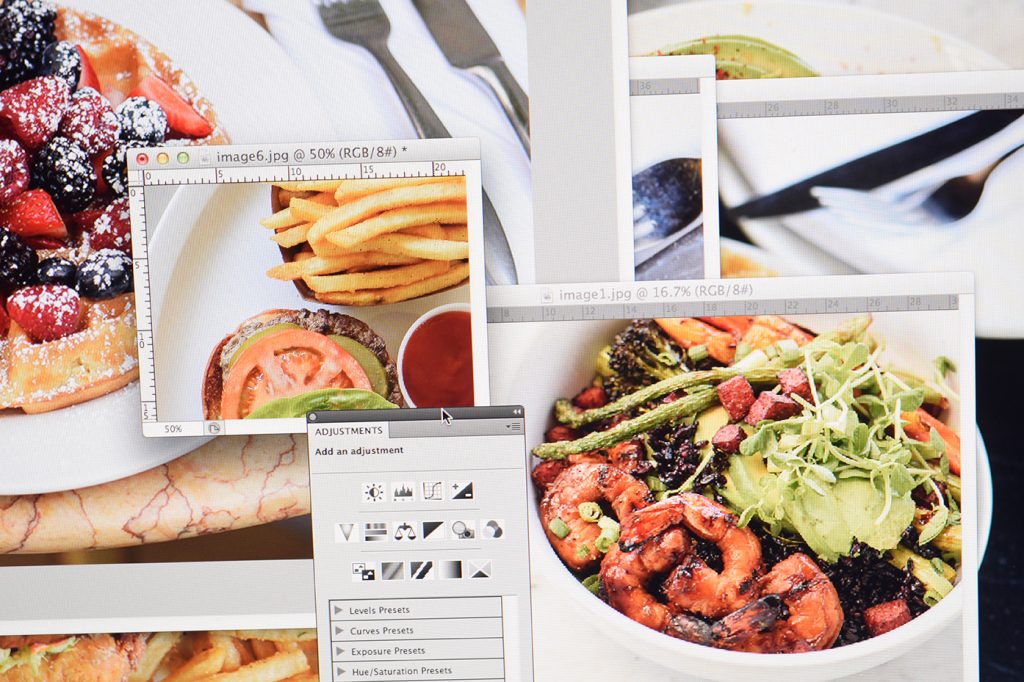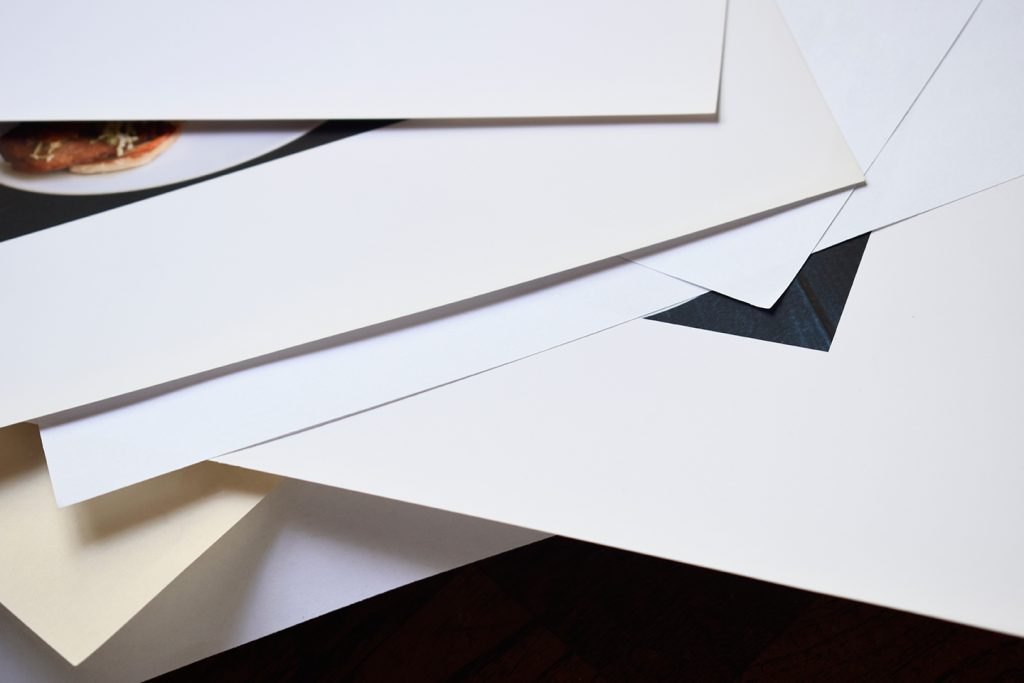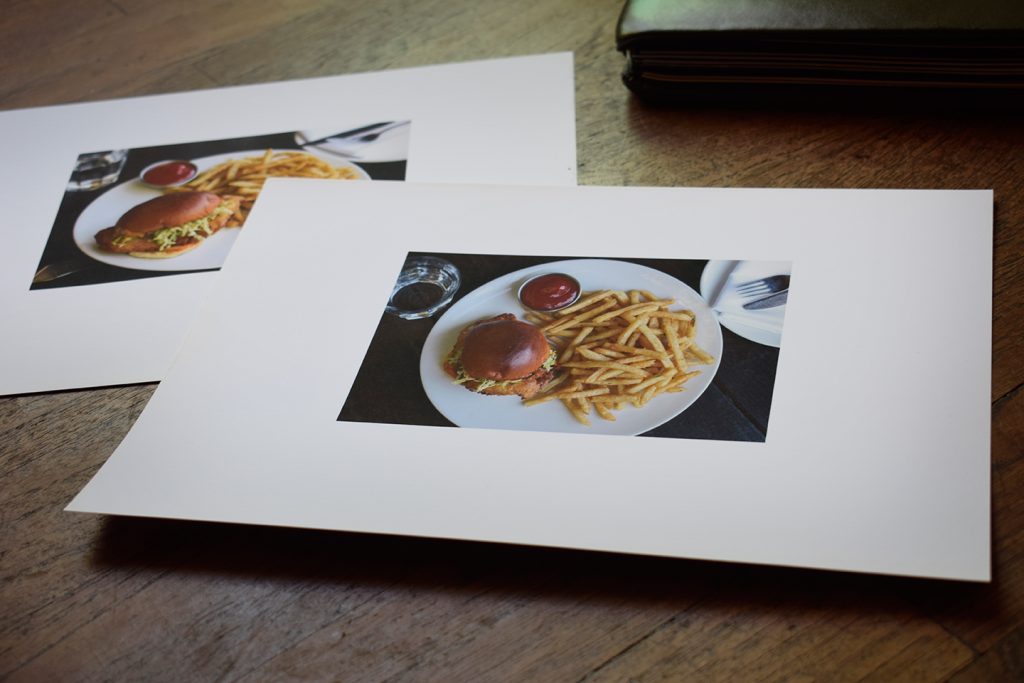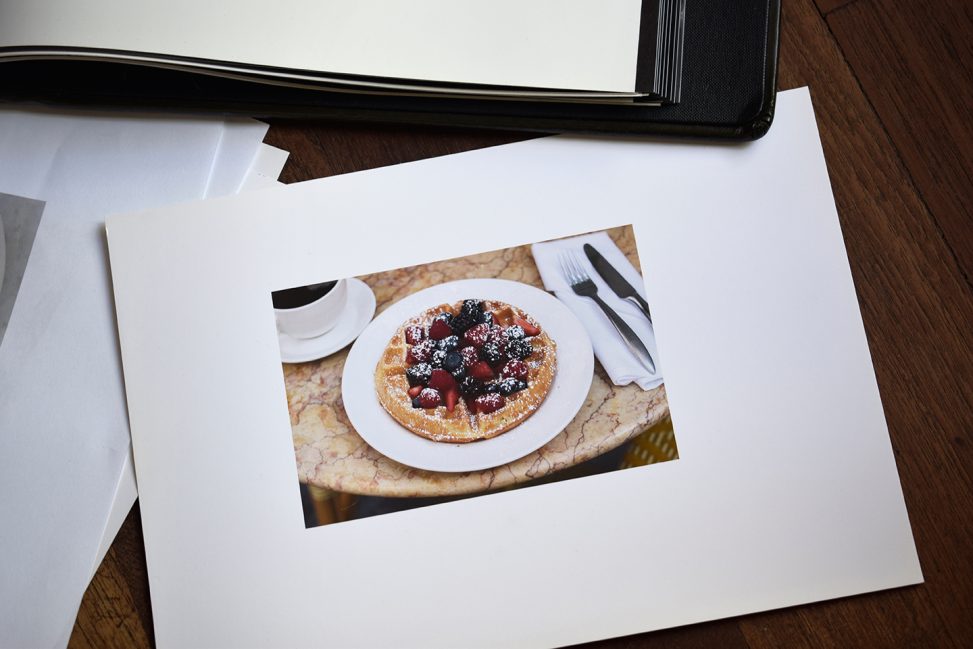A food photography course can be a great way to get a head-start in the industry. First off though, you’ll need to secure yourself a place on one. And for that you’ll need to put together a killer portfolio. Check out our guide explaining how to prepare a portfolio for a food photography course and you’ll soon be inundated with offers!
Although studying on a food photography course is by no means an essential requirement for those wanting to get into professional food photography, it can certainly be very beneficial. Presumably if you’re reading this article it’s because you’ve already decided that you want to do a food photography course. You probably also know that everything rides on putting together a great food photography portfolio. This article will show you how.

It takes time, thought, and energy to put together a strong food photography portfolio
What is a Food Photography Course Looking for from Candidates?
As with any photography course, the main criteria a school or workshop-leader will be looking for in candidates is an exceptionally strong portfolio and a healthy dose of enthusiasm.
Or at least that’s the romantic image.
Yes, these two qualities are absolutely essential if you are to be accepted onto a food photography course. But it would be misleading to suggest that if you just roll up with a passionate speech and a few shit-hot photos that you’ll be guaranteed a place. Schools are also interested in more mundane stuff; like, you know, students who actually bother turning up to class regularly, and who pay their fees on time (particularly this latter part!).
In practice then, beyond passion and talent, schools are also looking for people who are diligent, responsible, and can follow instructions. One of the first things they’re going to consider, then, is whether you actually bothered to read the application guidelines. And, most importantly, complied with them.
While a lot of schools are reluctant to turn away fee-paying students these days, if the course is any good they will likely have plenty of strong candidates to choose from, and will need to narrow the selection down. Don’t give the school an excuse to strike you off the shortlist before they’ve even looked at your portfolio. Make totally sure that you have understood the specific requirements of the school and/or course and followed the portfolio submission guidelines to the letter. Things will not go well if you turn up at the interview hauling an old-school portfolio case stuffed with prints if in actual fact you were merely asked to provide a link to an online gallery of your work.
Perhaps the single most important requirement to look out for is whether there is a limit to how many photos you are allowed to include in your portfolio. Even if there isn’t a maximum number though, don’t take this as in invitation to cram in every single photo you’ve ever taken.
What’s the right number of photos to include in a food photography portfolio then? We’ll get to that in a short while. First though, let’s deal with some more fundamental considerations.
What Kind of Portfolio do You Need to Apply to a Food Photography Course?
If the school or course-leader has given strict instructions as to how you should present your work, then this question has likely already been answered for you. If not, the first matter you’ll need to consider is whether you should go for a digital or a printed food photography portfolio.
To a certain extent this will just come down to personal preference. However, you should also consider whether it is a food photography course at a brick and mortar school, or a short workshop with professional photographer? Will there be a face-to-face interview, or just an online application? It’s also worth remembering that a digital portfolio will likely cost zero to put together, whereas a printed one requires some real investment.

Consider whether a digital or printed portfolio will be best for your needs
If your choice is not restricted by any of the above considerations, then really the main things to consider is which format will work best for your photography. For example, a printed portfolio might be the most logical option if you are the kind of photographer who gets excited about shadow and light; the tactile qualities of food; the texture of background surfaces. In this case, the look and feel of high-end photo-paper could really accentuate these qualities in your photos. On the other hand, if you have been experimenting with dark food photography, and don’t want to risk precious shadow detail becoming lost, then perhaps a digital portfolio will guarantee better viewing conditions.
In fact this is a very important point to consider whenever preparing a portfolio: you can never be sure what lighting and viewing conditions your portfolio will be seen in. It’s bad enough when you get to present the portfolio yourself in-person – where there is at least the possibility of asking the interviewer to go to the window to look at your work under better light – but imagine the varying conditions in which your portfolio will looked at when you just drop it off or send it in and are not there to make such a request!
If the thought of your beautiful prints being viewed in a gloomy office or under the reflective glare of some horrendous neon-strip lights is too much to bear, then go for the digital option (and cross your fingers that it’ll be viewed on a decent monitor!).
How to Design a Food Photography Portfolio?
To a certain extent, the kind of design you opt for will depend on the format you will use for the portfolio: what works digitally won’t necessarily be the best option for a printed portfolio. And vice versa.
Generally speaking though, you should keep things very simple. Design decisions should never be made purely for the sake of design, but always in the service of displaying your photos at their best. Never lose sight of this. You will not be offered a place on a food photography course for showing a beautiful and innovatively designed portfolio; you will be accepted because you show real potential as a food photographer. This means that the photographs must come first. If the interviewer is looking at the design of your portfolio, rather than its contents, then you’ve already lost the battle.
Its entirely up to you of course, but here at Best Food Photography we think that photos just generally look better with borders. And the safest bet is always going to be white borders. Bright primary colored backgrounds or retro pastels are very “now”, but this look needs to be done with both justification and care. Don’t unthinkingly opt for a fashionable design just because you see lots of other people doing it. In the end all you’ll demonstrate to the viewer is that you’ve spent too much time on Instagram. if you go for a distinctive and dominant form of portfolio presentation then you better have a good reason for it – or be prepared to be well and truly taken apart by the interviewer.

When designing a printed portfolio, the paper stock you use can make a big difference to the final result
If you choose to go for a printed portfolio you will not only need to think about the sequence of the images and the page layout, but also the printing technique you will use; the finish, weight and feel of the paper stock; and how you will present everything together as one unified portfolio.
A leather-bound portfolio book with removable plastic sleeves is probably the most professional and hard-wearing option (although note that those black zip-up portfolios that art students carry their work around in are not well regarded in the professional world). Alternatively, a custom-made clam-shell portfolio box with individual prints inside can be a good alternative option. However, the disadvantage of this latter kind of portfolio is that you do not get to control the order in which the viewer will look at each photo.
Also keep in mind that even expensive non-reflective sleeves produce a certain amount of glare and can make it difficult to view darker photos. What’s more, there would be little point in spending money on luxurious high-GSM cotton rag paper if you’re only going to display the prints under thick acetate sleeves. In this case you could get away with some lightweight (and cheaper) paper stock.
Conversely, if you do want to display your work on high quality photo paper, then it would probably be better to have your loose prints bound together as a book by a custom bookbinding company. Certainly a portfolio of fine prints on very slightly textured semi-matte paper can be a real joy to look at (and touch) and will create a really refined and artistic impression. However, bear in mind that without protective sleeves your expensive prints risk quickly becoming ruined if you will not always be around to look after your portfolio when it is viewed.
Even if you opt to put together a digital photography portfolio, and therefore don’t need to worry about paper or a portfolio case, you should still consider the contents and layout of your portfolio very carefully. Don’t get too caught up in the design process though. A cleanly designed and well thought out PDF is all that’s required, and gimmicky design tricks or flashy slideshows will not help your cause. Let your food photography speak for itself.
What to Include in a Food Photography Portfolio?
So you’ve decided on the format and are thinking about a style of design that will suit your work. Cool. But what exactly are you going to put into your portfolio?
What’s the point of a food photography portfolio anyway? To show all the best photos you ever took? That sounds logical, right?
It’s wrong though.
Certainly you must only show your best work (we’ll consider this more in a second). But you probably shouldn’t show all of it.
Ideally a portfolio isn’t just a random selection of “greatest hits”. Instead, like all the best music LPs, it’s a more structured collection of work that sits together in a unified way. In fact, you can almost think of it like a concept album!

When applying for a food photography course, it’s essential that you edit your portfolio down to a strong and succinct series of photos. With only a few pages to convince the interviewer, showing two similar images is a wasted opportunity.
A strong, streamlined portfolio shows confidence and direction. This means that you might need to leave out some of your favorite shots (“kill your heroes”, as they say) if they don’t fit in with the overall feel of your portfolio – sacrificing them in the name of cohesion. You should also make sure you haven’t included two similar shots (i.e. of the same subject) purely because you love both and can’t choose between them: one of them has to go, otherwise all you’re doing is publicly demonstrating your inability to edit.
Just as the best Instagram accounts hold together with a strong visual identity, the best photography portfolios have a clear personality, confidently announcing their presence to the world in a few concise visual statements.
Consider adding a title page featuring thumbnails of all the work in the portfolio. This will make it easier for viewers to quickly remember what you do, and also easier to find you again among the stacks of other applicants without having to look through the entire portfolio each time.
Finally, whether its a printed or a digital portfolio, make sure to include your name and contact details somewhere!
Ordering and Sequencing
It’s not just what goes into your portfolio that matters though, it’s also the order you arrange everything in. Think about how the series of images flows as you look through the portfolio. It can be good to surprise viewers with the next image, but the sequencing should never jar. On the other hand, if you have images that are in some way similar (in color, composition, subject etc.), try distributing them evenly throughout the portfolio rather than grouping them all together.
Aside from considering how the portfolio works as a sequence or narrative, you also need to order it for maximum impact. You can almost think of it like a movie, with an action-packed intro, a solid middle, and a spectacular finale. Your first few images should wow the viewer, hooking them in right from the start with a punch. Photos in the middle should be solid players that keep things moving along nicely. And then. Bang! You end with one or two of your very best shots, leaving people with a great final impression that matches their initial reactions.
How Many Photos Should You Include in a Photography Portfolio?
The old rule still stands: better to show just a very few good photos and leave the viewer wanting more, rather than show the viewer more so that they wish there were less. Or to put it another way: show enough that people see you can take a good shot, but not so many that they can see that you take mediocre photos too.
What is photography? What do you do when you shoot? What’s going on when you look through the viewfinder of your camera? Do you just shoot the first thing you see when you put the camera up to your eye? Or do you move the camera to a different position, change the angle, pull-back from the subject, or move in closer? What are you doing when you do all this?
You’re editing, that’s what. Because what it means to be a photographer is to edit. To edit the world: to make decisions about what to include or exclude from the frame; to choose to press the shutter now! Rather than now. Or now.
As a photographer – any kind of photographer – this editing process continues long after you’ve put down the camera and stopped shooting. It happens when you sit and look through all your images on the monitor and choose the best ones to retouch. It definitely needs to continue when it comes to deciding which photos to put in your portfolio. And most importantly, which ones not to put in your portfolio.
Edit.
Now edit again.
You should probably aim to include between about 12 and 20 photos in your portfolio. Certainly no more than 25 at this stage of your career. Again though, better to include just 8 amazing shots than 20, if 8 out of the 20 are amazing and the rest just filler. All this would do is dilute the quality of the 8 amazing ones.

Feedback from others can be helpful at all stages of preparing a portfolio
At all stages of editing, it can be great to get people whose opinion you trust to offer feedback on your selection. This is especially important because it can be so difficult to be objective about your own work. As photographers, we tend to value the shots that have some kind of special meaning for us, or even just because a lot of hard work went into making them. But these are not good reasons for including them in your portfolio. The best photo is not necessarily the one that was most difficult to produce. For this reason it can be great to hear which images others like, and which sections of your edit they think work best. And if nobody else likes what you like, then at the very least you need to question your own motives.
However, while you should always be open to listening to what others have to say, and to giving their opinions serious consideration even if you initially disagree with them, don’t allow yourself to be swayed too far from your initial instincts.
In fact, getting others to critique your edit can often be the best way of finding out how you really feel about your portfolio: if you are uncomfortable with a particular image or section as others look over it, this is surely a sign that something needs to change here. Conversely, if you find yourself steadfastly refusing to budge on the decision to include a certain image in the portfolio – and you have genuinely examined your motives behind this – then it should probably stay (although of course there’s always the possibility that you are wrong, but just incredibly pigheaded).
What if You Haven’t Done Much Food Photography Before?
It should go without saying, but if you were already an expert food photographer with a huge archive of stunning food photography shots, you probably wouldn’t be applying to do a food photography course. Realistically, then, you might not have a huge amount of work to show just yet. That’s totally normal.
With that said though, whoever does the interviewing or selecting for your chosen food photography course will want to see evidence of your talent and enthusiasm for photography and food in general. So even if you haven’t done much food photography before, but have experience in other areas of photography – or cooking – then clearly it is better to demonstrate something of your general photographic and/or culinary skills rather than just show nothing at all.
Even if you don’t have much in the way of actual food photography to include in your portfolio – and so need to show other styles of photography such as landscapes, portraits etc. – carefully consider the selection of images in order to show that you possess the kinds of skills that make for a good food photographer.
What do we mean by this? Well, a good food photographer will often have an eye for details; a heightened awareness of texture, form and light; an ability to communicate the four non-visual senses in visual form; a certain sensibility for instinct and emotion. None of these qualities are totally unique to food photography though, and work displaying a heightened awareness of all things subtle and sensuous can be found in many other styles of photography too. Try to pick images that show that you are attuned to these things – whether it’s droplets of water on autumn leaves, or the fall of hair onto a person’s shoulders.
Clearly though, it will put you in a much stronger position if you can show some actual food photography too. So why not shoot some especially for the interview? And tell the interviewer that you’ve done this, as it proves that you are serious about getting a place on the course.
What if you can’t cook though? Well, you’re just going to have to find someone who can and who is willing to help you. If you want to be a food photographer you will not get far if you can’t show a little resourcefulness and initiative. Hell, order take-out and get creative with the lighting, location and props if you have too. Do whatever it takes to show that you are passionate about getting on this food photography course. Check out our guide to beginner’s food photography tips if you need some pointers.
Final thoughts
So you’ve got your portfolio together and you’re all set to apply to a food photography course? It doesn’t end there though. If you’ll be going for a real-world interview you’ll also need to prepare yourself: interviewers will likely want you to talk through the work in your portfolio and will ask you questions about it. Make sure you’ve got lots to say in response!
And even if you will just be sending a digital portfolio, you’ll likely also be asked to write some kind of cover letter or introductory statement about your work. Don’t leave this to the last minute, as it can often be the deciding factor in getting a place on the course.
Finally, remember that no one is expecting you to be up to professional standards yet, otherwise you wouldn’t be considering doing a food photography course in the first place. What’s important is that you show promise and potential. This means demonstrating that you have some talent, that you are willing to work your ass off, and most importantly that you want to learn. All of this needs to be communicated by your portfolio. And by you, yourself, of course.


Leave a Reply